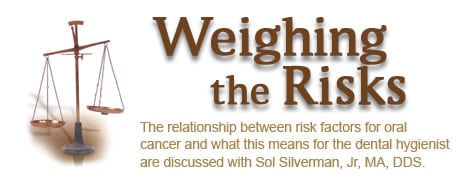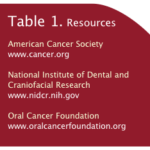
Weighing the Risks
The relationship between risk factors for oral cancer and what this means for the dental hygienist are discussed with Sol Silverman, Jr, MA, DDS.
Q. How should the various risk factors such as tobacco and alcohol use, exposure to sunlight, age, and race, be weighed?
 A. First, exposure to ultraviolet rays is actually related to lip cancer, which I include as an oral cancer. I advise my patients who enjoy outdoor activities and/or who work outside to not only keep their lips lubricated but to also use sunscreen on their lips. Approximately 4,300 cases of lip cancer are diagnosed each year in the United States, with 100 to 150 cases resulting in death.1 It most often occurs on the lower lip and is more prevalent in men.2
A. First, exposure to ultraviolet rays is actually related to lip cancer, which I include as an oral cancer. I advise my patients who enjoy outdoor activities and/or who work outside to not only keep their lips lubricated but to also use sunscreen on their lips. Approximately 4,300 cases of lip cancer are diagnosed each year in the United States, with 100 to 150 cases resulting in death.1 It most often occurs on the lower lip and is more prevalent in men.2
Race is about genetics. The incidence of pharyngeal cancer rate is higher in African-Americans than any other ethnic group.3 The survival rate for those with pharyngeal cancer is poor but whether this is due to access to health care, education, or genetics is unclear. But certainly the death rate is higher in African-Americans. More caucasians have oral cancer because they comprise a larger part of the population. Even taking this into consideration, African-Americans have a higher incidence of pharyngeal cancer.
Tobacco use is the most pertinent risk factor. In the United States each year, more than 440,000 preventable deaths occur due to tobacco, including oral cancer and many other illnesses.4 But we don’t clearly understand how tobacco use relates to other factors. For example, some people who have smoked a pack or more of cigarettes per day for their whole lives don’t develop head and neck cancer. As a matter of fact, probably about 40% of the patients I see with oral precancerous lesions, eg, leukoplakia, are either nonsmokers or they haven’t smoked for 5 or 10 years. In the prevention education department, tobacco cessation must be emphasized because it prevents a whole host of diseases, including oral and pharyngeal cancers.
But tobacco cessation is not the only factor. This is why in my practice we emphasize the total picture, including alcohol use, nutrition (fruits and vegetables), exercise, aging, viruses, and genetics. Genetics cannot be fixed but we can attempt to control the other risk factors. Cancer in general is a disease associated with aging and as we extend longevity, we extend the risk.
THE HPV VIRUS
Q. Does the human papilloma virus (HPV) play a role?
A. Evidence does indicate a possible link between oral and pharyngeal cancers and the human papilloma virus, particularly the HPV Type 16, but the research is in the preliminary stages. At least 10 types of HPV have been associated with carcinogenesis but 16 is the virus that seems to disrupt normal cell activity the most.
We know that women infected with HPV definitely have a higher risk of cervical cancer. HPV is sexually transmitted with the risk of infection increasing with multiple sexual partners. So as research investigates the link between HPV and oral and pharyngeal cancers, a possible association will be determined. Investigators may find that individuals who have multiple partners may be at a higher risk for oral cancer but this is only conjecture at this point.
Q. Are there other possible risk factors that may not have been discovered yet or undergone research?
A. More and more research is being performed at a molecular level involving chromosomes and genes. The findings will further explain important information relative to risks, management, and prognosis. For example, a few articles have been published that show that smokeless tobacco may be safer than combustible tobacco,5,6 but no use of tobacco is safe. Studies are ongoing to determine anticancer activity in vegetables and fruits that contain anti-oxidant proteins, such as lycopene in tomatoes and elagic acid in grapes. Research is looking at how much wine is healthy to consume and whether the alcohol content makes a difference.

In my opinion, moderation is the key. Try not to smoke, try to minimize the amount of alcohol intake, eat a nutritious diet. There’s nothing we can do about the viruses unless you warn people who have multiple sexual partners to use a barrier method of protection. Genetics is a luck of the draw but research is being done on possibilities like stem cells.
RESOURCES
Q. What are some resources you would recommend for more information?
A. Good places to start are with the American Cancer Society and the Oral Cancer Foundation. They both provide information on oral and pharyngeal cancers. Look for literature that specially addresses prevention, risk factors, and early detection. The National Institute of Dental and Craniofacial Research is also a good resource.
Dental offices need to stop looking at only those over the age of 45 who smoke and drink. Oral cancer examinations need to be done on every person beginning in early adulthood. Then patients are used to receiving the exam and offices are used to performing it. Hundreds of thousands of precancerous lesions exist and if these are caught initially, some cancers can even be prevented from occurring in the first place.
Q. What age specifically would you recommend dental hygienists begin performing oral cancer examinations?
A. As soon as teenagers begin adulthood—18. Starting younger is fine but the yield will be very low for even precancerous legions. The only factor that I think circumvents this thinking is if the young person uses smokeless tobacco. The use of smokeless tobacco is growing among young people and precancerous lesions will definitely exist in this population.
REFERENCES
- Lip cancer. Baylor College of Medicine. Available at: www.bcm.edu/oto/grand/5693.html. Accessed March 14, 2007.
- Are your lips sealed? Massachusetts Dental Society. Available at: www.massdental.org/public/wordofmouth.cfm?doc_id=1581. Accessed March 14, 2007.
- Morse DE, Kerr AR. Disparities in oral and pharyngeal cancer incidence, mortality and survival among black and white Americans. J Am Dent Assoc. 2006;137:203-212.
- Fagerstrom K. The epidemiology of smoking: health consequences and benefits of cessation. Drugs. 2002;62Suppl2:1-9.
- Martinet Y, Bohadana A, Wirth N, Spinosa A, Beguinot E. Risk reduction strategies in smoking. Rev Mal Respir. 2006;23(4 Suppl):109-118. French.
- Daniel Roth H, Roth AB, Liu X. Health risks of smoking compared to Swedish snus. Inhal Toxicol. 20051;17:741-748.
From Dimensions of Dental Hygiene. April 2007;5(4): 30, 32.

